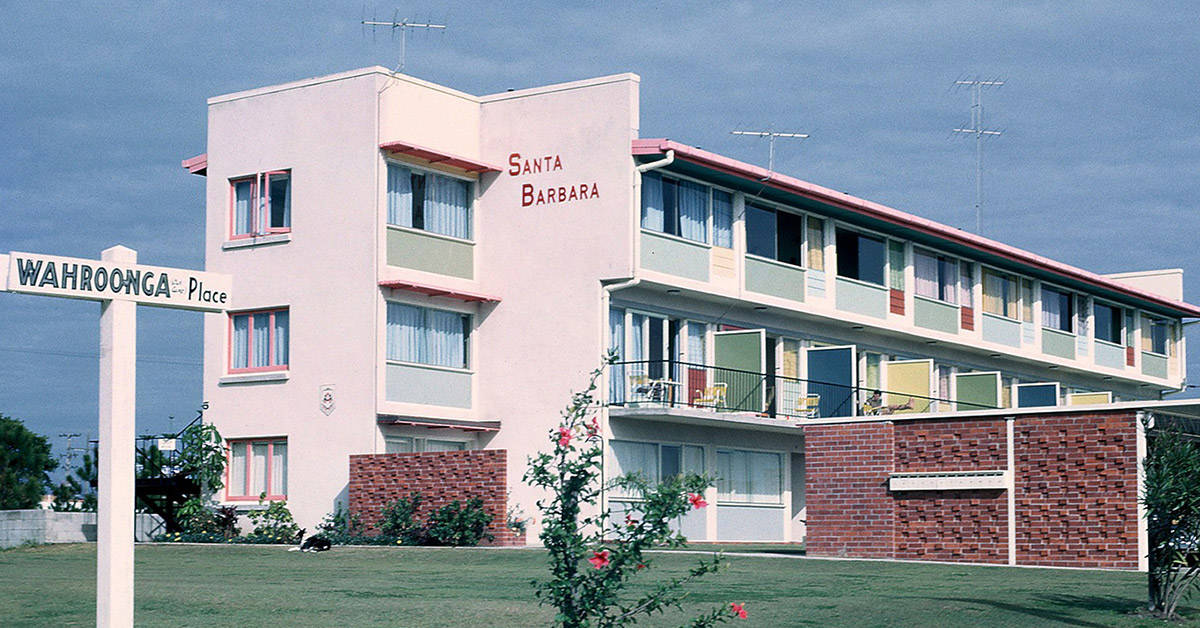
The Evolution of Gold Coast Residential Architecture from the 20th Century until today
Tourist Hub
The Hotel and boarding house
The Hotel and boarding house
Leading on from the hotel history, which was the original visitor accommodation option on the Gold Coast, came the boarding house or guest house, which became very popular in the 1950s and 1960s. The guest house represented fun and frivolity and a place for socialising. Traditionally, these boarding houses and guest houses were timber and corrugated iron, with wide verandahs for shelter from the sun.
The American inspired California Bungalow-Queenslander
The American inspired California Bungalow-Queenslander
Because of the Queensland climate and limited access to resources and materials, a hybrid was produced in the Gold Coast between the American influenced California Bungalow and the traditional Queensland house, featuring weatherboards and corrugated iron – the vernacular “timber and tin: style”. This hybrid style of housing became known as the Queenslander and was popular up until the second world war.
The Flats
The Flats
The Fibro Beach Shack
The Fibro Beach Shack
The Gold Coast Beach House
The Gold Coast Beach House
The US influence continues
The US influence continues
This was also during the time when glamourous American stars such as Frank Sinatra and the rat pack were very popular and building fashionable modernist homes in sunny California’s Palm Springs which Gold Coast residents began to emulate.
The Motel
The Motel
The linear highway running through the collection of various beach settlements that forms the Gold Coast meant that competition amongst motel operators was strong, and there was a need for them to stand out from the rest and draw patrons in. From this, Vegas style signage emerged, evident in iconic Motels such as the Pink Poodle, as well as elaborate architectural facades to attract attention.
Behind these showy frontages however, Motel architecture was typically very basic in its form. Other features were incorporated to create a sense of fantasy and the exotic, offering holiday makers an escape from their traditional pre / post-war homes and everyday lives to experience luxuries they couldn’t normally afford.
These offerings were prominently advertised on the street front signage and included heated swimming pools, springform diving boards, colourful tropical landscaping (influenced strongly by the new Pacific Island resorts that were in vogue at the time), Televisions, ensuite bathrooms, air conditioning, kitchens, modern imported furniture, refrigerators, BBQ facilities, games rooms and the classic precooked Motel breakfast, ordered the night before and delivered on a tray through a special hatch to your room at the time of your choosing.
The Walk-up
The Walk-up
The 3-storey walk-up became popular as they could be developed on a typical single residential lot.
The rise of the high-rise
The rise of the high-rise
This coincided with the popularity of airline travel, bringing even more visitors to our city, and the Gold Coast exploded with a spate of highrise apartment buildings, particularly in Surfers Paradise, the entertainment heart of the city. By the early 70s, over a third of the dwellings on the Gold Coast were apartments.
A mixed bag of international trends
A mixed bag of international trends
We’ve experienced the passing fads of Greek style (whitewash walls and curved balconies, bold highlight colours), Tuscan style (arched windows, terracotta tiles and pastel colours), Mexican style (whitewash walls, flat rooves, fake logs, colourful mosaic tiles) and Balinese style (Timber structures, thatched rooves, huts and pavilions, imported stone artefacts).
The price of growth has been great on the Gold Coast as we continually strive to find our identity as a city.
Our limited architectural heritage is rapidly disappearing as our original dwellings, many less than 50 years old, are demolished to make way for newer bigger grander homes. As a result, iconic Gold Coast suburbs like the Isle of Capri is now dubbed the ‘Isle of Debris’.
Where to from here?
Where to from here?
Quality timeless, sophisticated architecture is becoming more prevalent, and can be attributed to a diverse range of factors including travel, social media, the internet, and even reality TV which has exposed more of the population to the value and importance of quality design.
Our City Council has also played a key role in transitioning our City from a giant “theme park” into an international metropolis by establishing a City Architect role and developing a town plan that rewards good design and civic responsibility with development bonuses.
Having had the eyes of the world focussed intently on our city during the Commonwealth Games, we are now likely to be entering a period of robust growth and prosperity.
As an Architect who has spent most of his career working in this wonderful city, I have delighted in watching the Gold Coast mature, and am very excited about the future and the role I can continue to play in the practice of architecture, shaping the urban fabric that makes this one of the most liveable cities in the world.
0 Comments